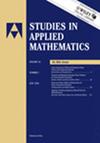直线上Sawada-Kotera方程的非线性傅里叶变换
IF 2.3
2区 数学
Q1 MATHEMATICS, APPLIED
引用次数: 0
摘要
本文给出了定义在实直线上的Sawada-Kotera方程初值问题的一个Riemann-Hilbert (RH)问题形式。假设解存在,我们建立了该解可以有效地表示为求解一个3 × 3$ 3 \ × 3$矩阵RH问题。值得注意的是,该RH问题的表述涉及四个谱函数:s 32 $s_{32}$, s 33 $s_{33}$, s 32 $ A $s^A_{32}$,和s 33 A $s^A_{33}$,这是通过对初始数据进行非线性傅里叶变换得到的。此外,本文还进行了详细的谱分析,为应用非线性最陡下降法确定Sawada-Kotera方程解在实线上的长期渐近行为奠定了基础。本文章由计算机程序翻译,如有差异,请以英文原文为准。
Nonlinear Fourier Transforms for the Sawada–Kotera Equation on the Line
This paper presents a Riemann–Hilbert (RH) problem formalism for the initial value problem of the Sawada–Kotera equation defined on the real line. Assuming the existence of a solution, we establish that this solution can be effectively represented by solving a matrix RH problem. Notably, the formulation of this RH problem involves four spectral functions: , , , and , which are obtained via a nonlinear Fourier transform applied to the initial data. Furthermore, this study conducts a detailed spectral analysis, providing a foundation for the application of the nonlinear steepest descent method to determine the long-time asymptotic behavior of solutions to the Sawada–Kotera equation on the real line.
求助全文
通过发布文献求助,成功后即可免费获取论文全文。
去求助
来源期刊

Studies in Applied Mathematics
数学-应用数学
CiteScore
4.30
自引率
3.70%
发文量
66
审稿时长
>12 weeks
期刊介绍:
Studies in Applied Mathematics explores the interplay between mathematics and the applied disciplines. It publishes papers that advance the understanding of physical processes, or develop new mathematical techniques applicable to physical and real-world problems. Its main themes include (but are not limited to) nonlinear phenomena, mathematical modeling, integrable systems, asymptotic analysis, inverse problems, numerical analysis, dynamical systems, scientific computing and applications to areas such as fluid mechanics, mathematical biology, and optics.
 求助内容:
求助内容: 应助结果提醒方式:
应助结果提醒方式:


